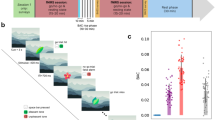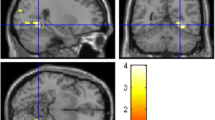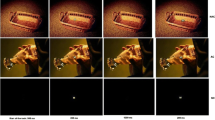Abstract
Rationale
Successful response inhibition is associated with right-lateralized inferior frontal cortex (IFC) activity, and alcohol impairs this inhibitory control, thereby enhancing false-alarm responses in the Go/No-Go task. However, the neural correlates of effect of alcohol on response inhibition remain unclear.
Objective
This study characterized the acute effects of alcohol on IFC activity during Go/No-Go tasks using near-infrared spectroscopy (NIRS).
Methods
Thirty-two subjects visited our laboratory twice: once for alcohol intake and once for placebo intake. On each visit, subjects performed Go/No-Go tasks immediately before and 10 min after intake of the alcohol or placebo. NIRS was used to evaluate IFC activity measured during Go/No-Go tasks.
Results
Alcohol significantly enhanced false-alarm responses in No-Go trials. NIRS analysis showed that IFC activity was greater in the right hemisphere than in the left hemisphere prior to alcohol or placebo intake. This right hemispheric superiority was eliminated in response to alcohol but not in response to placebo. Correlation analysis showed that subjects with right-lateralized IFC activity made fewer false-alarm responses in No-Go trials and that alcohol-induced inhibition of hemispheric IFC asymmetry resulted in higher false-alarm rates.
Conclusion
These findings suggest that the right IFC may mediate the acute effects of alcohol on inhibitory control. When the alcohol impairs the right IFC activity, subjects cannot inhibit the pre-potent responses for No-Go trials, resulting in enhanced false-alarm responses. Thus, this study successfully demonstrated the neural correlates of the alcohol effect in the right IFC activity during inhibitory control processes.





Similar content being viewed by others
References
Anderson BM, Stevens MC, Meda SA, Jordan K, Calhoun VD, Pearlson GD (2011) Functional imaging of cognitive control during acute alcohol intoxication. Alcohol Clin Exp Res 35:156–165
Aron AR, Fletcher PC, Bullmore ET, Sahakian BJ, Robbins TW (2003) Stop-signal inhibition disrupted by damage to right inferior frontal gyrus in humans. Nat Neurosci 6:115–116
Aron AR, Robbins TW, Poldrack RA (2004) Inhibition and the right inferior frontal cortex. Trends Cogn Sci 8:170–177
Barkataki I, Kumari V, Das M, Hill M, Morris R, O'Connell P, Taylor P, Sharma T (2005) A neuropsychological investigation into violence and mental illness. Schizophr Res 74:1–13
Boecker M, Buecheler MM, Schroeter ML, Gauggel S (2007) Prefrontal brain activation during stop-signal response inhibition: an event-related functional near-infrared spectroscopy study. Behav Brain Res 176:259–266
Bunge SA, Wright SB (2007) Neurodevelopmental changes in working memory and cognitive control. Curr Opin Neurobiol 17:243–250
Bunge SA, Dudukovic NM, Thomason ME, Vaidya CJ, Gabrieli JD (2002) Immature frontal lobe contributions to cognitive control in children: evidence from fMRI. Neuron 33:301–311
Chikazoe J, Konishi S, Asari T, Jimura K, Miyashita Y (2007) Activation of right inferior frontal gyrus during response inhibition across response modalities. J Cogn Neurosci 19:69–80
Clark L, Blackwell AD, Aron AR, Turner DC, Dowson J, Robbins TW, Sahakian BJ (2007) Association between response inhibition and working memory in adult ADHD: a link to right frontal cortex pathology? Biol Psychiatry 61:1395–1401
Cools R, Clark L, Owen AM, Robbins TW (2002) Defining the neural mechanisms of probabilistic reversal learning using event-related functional magnetic resonance imaging. J Neurosci 22:4563–4567
Delpy DT, Cope M, van der Zee P, Arridge S, Wray S, Wyatt J (1988) Estimation of optical pathlength through tissue from direct time of flight measurement. Phys Med Biol 33:1433–1442
Dougherty DM, Marsh-Richard DM, Hatzis ES, Nouvion SO, Mathias CW (2008) A test of alcohol dose effects on multiple behavioral measures of impulsivity. Drug Alcohol Depend 96:111–120
Durston S, Mulder M, Casey BJ, Ziermans T, van Engeland H (2006) Activation in ventral prefrontal cortex is sensitive to genetic vulnerability for attention-deficit hyperactivity disorder. Biol Psychiatry 60:1062–1070
Field M, Wiers RW, Christiansen P, Fillmore MT, Verster JC (2010) Acute alcohol effects on inhibitory control and implicit cognition: implications for loss of control over drinking. Alcohol Clin Exp Res 34:1346–1352
Fillmore MT, Blackburn JS, Harrison EL (2008) Acute disinhibiting effects of alcohol as a factor in risky driving behavior. Drug Alcohol Depend 95:97–106
Fillmore MT, Ostling EW, Martin CA, Kelly TH (2009) Acute effects of alcohol on inhibitory control and information processing in high and low sensation-seekers. Drug Alcohol Depend 100:91–99
Herrmann MJ, Plichta MM, Ehlis AC, Fallgatter AJ (2005) Optical topography during a Go-NoGo task assessed with multi-channel near-infrared spectroscopy. Behav Brain Res 160:135–140
Homan RW, Herman J, Purdy P (1987) Cerebral location of international 10–20 system electrode placement. Electroencephalogr Clin Neurophysiol 66:376–382
Jurcak V, Okamoto M, Singh A, Dan I (2005) Virtual 10–20 measurement on MR images for inter-modal linking of transcranial and tomographic neuroimaging methods. Neuroimage 26:1184–1192
Jurcak V, Tsuzuki D, Dan I (2007) 10/20, 10/10 and 10/5 systems revisited: their validity as relative head-surface-based positioning systems. Neuroimage 34:1600–1611
Leake CD, Silverman M (1971) The chemistry of alcoholic beverages. In: Kissin B, Begleiter H (eds) The biology of alcoholism, vol 1, Biochemistry. Plenum, New York, pp 575–612
Loeber S, Duka T (2009) Acute alcohol decreases performance of an instrumental response to avoid aversive consequences in social drinkers. Psychopharmacology 205:577–587
Obata A, Morimoto K, Sato H, Maki A, Koizumi H (2003) Acute effects of alcohol on hemodynamic changes during visual stimulation assessed using 24-channel near-infrared spectroscopy. Psychiatry Res 123:145–152
Obata A, Morimoto K, Sato H, Takeshita T, Kawaguchi H, Koizumi H, Maki A (2005) Effects of alcohol on hemodynamic and cardiovascular reaction in different genotypes. Psychiatry Res 139:65–72
Obrig H, Israel H, Kohl-Bareis M, Uludag K, Wenzel R, Muller B, Arnold G, Villringer A (2002) Habituation of the visually evoked potential and its vascular response: implications for neurovascular coupling in the healthy adult. Neuroimage 17:1–18
Okamoto M, Dan H, Sakamoto K, Takeo K, Shimizu K, Kohno S, Oda I, Isobe S, Suzuki T, Kohyama K, Dan I (2004) Three-dimensional probabilistic anatomical cranio-cerebral correlation via the international 10–20 system oriented for transcranial functional brain mapping. Neuroimage 21:99–111
Oldfield RC (1971) The assessment and analysis of handedness: the Edinburph Inventory. Neuropsychologia 9:97–113
Ostling EW, Fillmore MT (2010) Tolerance to the impairing effects of alcohol on the inhibition and activation of behavior. Psychopharmacology 212:465–473
Rubia K, Overmeyer S, Taylor E, Brammer M, Williams SC, Simmons A, Bullmore ET (1999) Hypofrontality in attention deficit hyperactivity disorder during higher-order motor control: a study with functional MRI. Am J Psychiatry 156:891–896
Rubia K, Russell T, Overmeyer S, Brammer MJ, Bullmore ET, Sharma T et al (2001) Mapping motor inhibition: conjunctive brain activations across different versions of go/no-go and stop tasks. Neuroimage 13:250–261
Rubia K, Smith AB, Brammer MJ, Taylor E (2003) Right inferior prefrontal cortex mediates response inhibition while mesial prefrontal cortex is responsible for error detection. Neuroimage 20:351–358
Rubia K, Smith AB, Brammer MJ, Toone B, Taylor E (2005) Abnormal brain activation during inhibition and error detection in medication-naive adolescents with ADHD. Am J Psychiatry 162:1067–1075
Rubia K, Smith AB, Taylor E, Brammer M (2007) Linear age-correlated functional development of right inferior fronto-striato-cerebellar networks during response inhibition and anterior cingulate during error-related processes. Hum Brain Mapp 28:1163–1177
Rubia K, Halari R, Cubillo A, Mohammad AM, Scott S, Brammer M (2010) Disorder-specific inferior prefrontal hypofunction in boys with pure attention-deficit/hyperactivity disorder compared to boys with pure conduct disorder during cognitive flexibility. Hum Brain Mapp 31:1823–1833
Soderlund H, Grady CL, Easdon C, Tulving E (2007) Acute effects of alcohol on neural correlates of episodic memory encoding. Neuroimage 35:928–939
Tsujii T, Watanabe S (2009) Neural correlates of dual-task effect on belief-bias syllogistic reasoning: a near-infrared spectroscopy study. Brain Res 1287:118–125
Tsujii T, Watanabe S (2010) Neural correlates of belief-bias reasoning under time pressure: a near-infrared spectroscopy study. Neuroimage 50:1320–1326
Tsujii T, Yamamoto E, Ohira T, Saito N, Watanabe S (2007) Effects of sedative and non-sedative H1 antagonists on cognitive tasks: behavioral and near-infrared spectroscopy (NIRS) examinations. Psychopharmacology 194:83–91
Tsujii T, Masuda S, Yamamoto E, Ohira T, Akiyama T, Takahashi T, Watanabe S (2009a) Effects of sedative and nonsedative antihistamines on prefrontal activity during verbal fluency task in young children: a near-infrared spectroscopy (NIRS) study. Psychopharmacology 207:127–132
Tsujii T, Yamamoto E, Masuda S, Watanabe S (2009b) Longitudinal study of spatial working memory development in young children. Neuroreport 20:759–763
Tsujii T, Masuda S, Akiyama T, Watanabe S (2010a) The role of inferior frontal cortex in belief-bias reasoning: an rTMS study. Neuropsychologia 48:2005–2008
Tsujii T, Okada M, Watanabe S (2010b) Effects of aging on hemispheric asymmetry in inferior frontal cortex activity during belief-bias syllogistic reasoning: a near-infrared spectroscopy study. Behav Brain Res 210:178–183
Tsujii T, Yamamoto E, Ohira T, Takahashi T, Watanabe S (2010c) Antihistamine effects on prefrontal cortex activity during working memory process in preschool children: a near-infrared spectroscopy (NIRS) study. Neurosci Res 67:80–85
Wall TL, Ehlers CL (1995) Acute effects of alcohol on P300 in Asians with different ALDH2 genotypes. Alcohol Clin Exp Res 19:617–622
Wall TL, Gallen CC, Ehlers CL (1993) Effects of alcohol on the EEG in Asian men with genetic variations of ALDH2. Biol Psychiatry 34:91–99
Wendt PE, Risberg J (1994) Cortical activation during visual spatial processing: relation between hemispheric asymmetry of blood flow and performance. Brain Cogn 24:87–103
Wendt PE, Risberg J (2001) Ethanol reduces rCFB activation of left dorsolateral prefrontal cortex during a verbal fluency task. Brain Lang 77:197–215
Wendt PE, Risberg J, Stenberg G, Rosen I, Ingvar DH (1994) Ethanol reduces asymmetry of visual rCBF responses. J Cereb Blood Flow Metab 14:963–973
Xue G, Ghahremani DG, Poldrack RA (2008) Neural substrates for reversing stimulus-outcome and stimulus-response associations. J Neurosci 28:11196–11204
Acknowledgements
This work was supported by the fund for Grant-in-Aid for Young Scientists (B) from the Ministry of Education, Culture, Sports, Science, and Technology (MEXT) of Japan. In addition, manuscript preparation was partly supported by the fund of Pfizer Health Research Foundation and Japan Science and Technology Agency (JST), under Strategic Promotion of Innovative Research and Development Program. There was no conflict of interest in this study.
Author information
Authors and Affiliations
Corresponding author
Rights and permissions
About this article
Cite this article
Tsujii, T., Sakatani, K., Nakashima, E. et al. Characterization of the acute effects of alcohol on asymmetry of inferior frontal cortex activity during a Go/No-Go task using functional near-infrared spectroscopy. Psychopharmacology 217, 595–603 (2011). https://doi.org/10.1007/s00213-011-2318-0
Received:
Accepted:
Published:
Issue Date:
DOI: https://doi.org/10.1007/s00213-011-2318-0




